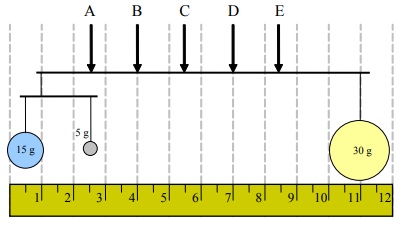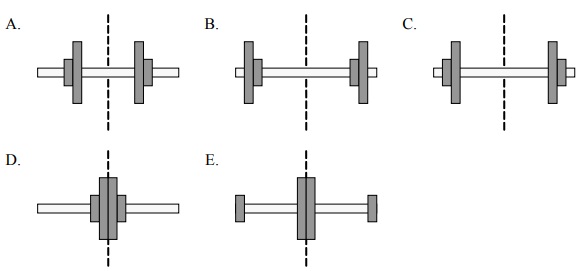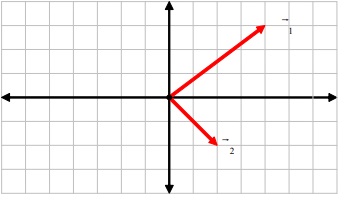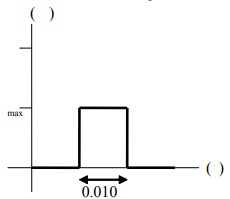Assignment:
1. You and a friend are moving a very heavy and irregular piece of furniture across a room. You are lifting it to prevent it from scratching your wooden floor. Your friend lets you pick where you are going to hold it and your friend will hold it at the other end (or some other place you tell your friend to hold it). To make it easier on yourself, you would:
A. Hold the end closer to the center of mass (your friend holds the other end).
B. Hold the end farther from the center of mass (your friend holds the other end).
C. Hold it at the center of mass and have your friend hold it from one of the other ends.
D. It doesn't matter where you pick - you'll both have to exert the same force no matter where you hold it.
E. Hold either end since you have to exert the same force no matter which end you pick.
2. Two acrobats flying through the air grab and hold onto each other in midair as part of a circus act. One acrobat has a mass of 60 kg and has a horizontal velocity of 5 m/s just before the grab. Another acrobat has a mass of 50 kg and has a horizontal velocity of -3 m/s just before the grab.
Their horizontal velocity immediately after they grab onto each other is:
A. 1.4 m/s
B. 3.0 m/s
C. 0.6 m/s
D. 2.0 m/s
E. 4.1 m/s
3. Your kid sister is making a mobile representing the earth, moon, and sun for her grade school science fair. The ruler is provided below to help you determine positions of the three hanging balls, of mass 15 g, 5 g, and 30 g, respectively. Of the five options provided, where would you connect a string to this mobile so that it would remain balanced when you hung it from the string?
(The rods and strings all have negligible mass compared to the balls.)

4. An 60-kg diver stands at the edge of a lightweight diving board, which is supported at two locations, as shown in the figure below. Determine the strength and direction of the force exerted on the diving board by the right-most support.

A. 100 N downard
B. 360 N upward
C. 360 N downward
D. 980 N downward
E. 980 N upward
5. What additional torque must your bicep muscle exert around your elbow if you are holding a 4.5 kg (10 lb) weight horizontally? (Assume your forearm is 0.30 meters long.)
A. 3 Nm
B. 11 Nm
C. 13 Nm
D. 4 Nm
E. 1 Nm
6. Two children are riding on a merry-go-round. Child A is at a greater distance from the axis of rotation than child B. Which child has the larger angular speed?
A. They have the same angular speed.
B. In order to find the speed we need to know the masses.
C. child A
D. In order to find the speed we need to know the radii.
E. child B
7. A karate student throws a round kick to a target pad during her workout in the dojo. Her foot moves at 15 m/s just before landing the kick and is in contact with the pad for 0.02 seconds until it comes to rest on the pad (for an instant). If the effective combined mass of her foot & lower leg is 8 kg, with what average force does she hit the pad?
A. 6000 N
B. 1200 N
C. 225 N
D. 80 N
E. 1800 N
8. Swimmers at a water park have a choice of two frictionless water slides (see figure). Although both slides drop over the same height , slide 1 is straight while slide 2 is curved, dropping quickly at first and then leveling out. How does the speed 1 of a swimmer reaching the end of slide 1 compare with 2, the speed of a swimmer reaching the end of slide 2?

A. 1 < 2
B. 1 = 2 2
C. 1 = 2
D. 1 > 2
E. We cannot compare the two speeds without knowing the swimmers' masses.
9. An object of mass 10.0 kg is initially at rest. A 100 N force causes it to move horizontally through a distance of 6.00 m along a frictionless surface. What is the change in the kinetic energy of this object?
A. 200 J
B. 60.0 J
C. 0.00 J
D. 20.0 J
E. 600 J
10. A constant force is applied to an object. If the angle between the force and the displacement is 90°, the work done by this force is:
A. negative.
B. positive.
C. 0 J.
D. Can't answer without knowing the speed of the object
E. Can't answer without knowing the exact angle.
11. The drive chain in a bicycle is applying a torque of 0.945 N m to the wheel of the bicycle. Treat the wheel as a hoop with a mass of 0.740 kg and a radius of 35.0 cm. What is the angular acceleration of the wheel?
A. 7.30 rad/s2
B. 10.4 rad/s2
C. 4.20 rad/s2
D. 3.64 rad/s2
E. 20.8 rad/s2
12. A piece of dirt (0.01 kg) is stuck in the tread of a spinning bicycle wheel. If the wheel is spinning at 60 RPM (rev/min) and the wheel has a radius of 0.35 meters, what is the magnitude of acceleration of the piece of dirt?
A. 2 m/s2
B. 5 m/s2
C. 10 m/s2
D. 18 m/s2
E. 14 m/s2
13. A metal bar has a frictionless axle going through its center of mass. You notice that the bar is not level (flat), but that it is tilted at a 30 degree angle (the right end is below the horizontal and the left end is above the horizontal) and that the bar is not rotating away from this orientation. You can say that:
A. The net force isn't zero and the net torque is counter-clockwise on the bar.
B. The net force is zero but the net torque is counter-clockwise in the bar.
C. The net force is zero but the net torque is clockwise on the bar.
D. The net force isn't zero and the net torque is clockwise on the bar.
E. The net force is zero and the net torque is zero on the bar.
14. Mars has about 1/10 the mass of the Earth and a radius 1/2 that of the Earth. Approximately, what is the acceleration of gravity (g) on Mars?
A. 25 m/s2
B. 10 m/s2
C. 4 m/s2
D. 2 m/s2 E. 12 m/s2
Mars has a radius 3.41 x 106 m and a mass of 6.42 x 1023kg. What is the acceleration due to gravity on the surface of Mars?
A. 3.7 m/s2
B. 9.8 m/s2
C. 14.7 m/s2
D. 15.9 m/s2
E. 1.26 x 107 m/s2
16. An object of mass 7.0 kg is released from rest a certain height above the ground. Just before it strikes the ground it has a kinetic energy of 1750 J. From what height was the object dropped?
Ignore air resistance and use g = 10 m/s2.
A. 0.0 m
B. 30 m
C. 15 m
D. 10 m
E. 25 m
17. Below, a set of five dumbbells are shown, where the weights have been moved around to different locations along the bar. The mass of the dumbbell in each case is the same as in all the others. Which dumbbell would require the greatest torque in order to rotate it about the axis indicated by the dashed line with a constant angular acceleration of 5 rad/s2?

18. A firecracker, initially at rest on a level, frictionless table, explodes into three fragments. The momentum vectors of two of the fragments are shown, as viewed from above. What would the momentum vector of the third fragment have to be? Each grid unit represents one kilogram-meterper-second (kg·m/s).

A. →3 = (2 kg . m/s) + (1 kg . m/s)
B. →3 = (-6 kg . m/s) + (-1 kg . m/s)
C. →3 = (-7 kg . m/s)
D. →3 = (-2 kg . m/s) + (-5 kg . m/s)
E. →3 = (2kg . m/s) + (2 kg . m/s)
19. In a particular case, to stretch a relaxed muscle 2.6 cm requires a force of 25 N. Find the Young's modulus for the muscle tissue, assuming it to be a uniform cylinder of length 0.24 m and cross-sectional diameter of 8.2 cm.
A. 12500 N/m2
B. 25040 N/m2
C. 53500 N/m2
D. 43700 N/m2
E. 35050 N/m2
20. A 0.100 kg rubber ball is thrown horizontally with a speed of 10 m/s at a vertical wall. The ball rebounds with the same speed. The force of the collision on the ball is shown in the graph below.

What is the value of the maximum force?
A. 2 N
B. 20 N
C. 2000 N
D. 200 N
E. Impossible to tell